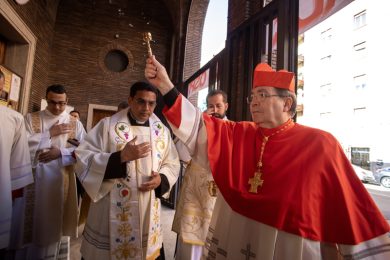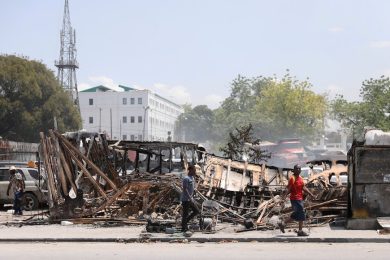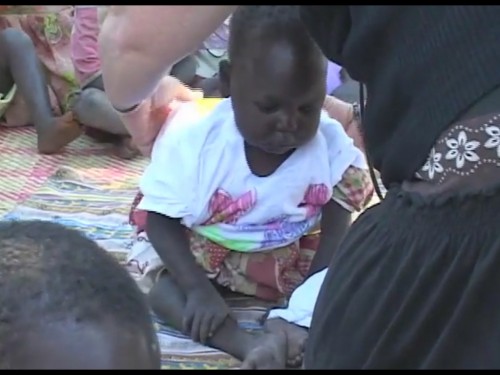Online Lesson:
These online lessons may be used:
• by individuals anytime, anywhere.
• in group settings — families, faith sharing groups, faith formation programs, and schools.
• in “flipped” classroom situations for people to view before meeting face to face.
You may just want to use a suggested video, story, or question — in anyway that helps us recognize that God’s mercy is anytime, anywhere, and we are called to be merciful as well.The structure of the lesson is based on Msgr. Francis Kelly’s Ecclesial Method.
Step 1 – Preparation: Each lesson will begin with a video and prayer to help us focus on the Works of Mercy in General.
Works of Mercy Reflection:
What gift do you have that can be put to the service of the poor?
Prayer:
Loving God,
As You clothe us in Your mercy and love, help us to clothe our neighbors physically as well as psychologically, emotionally and spiritually. Give us the willingness to cover the cold and uncomfortable with warm clothes that are effective, not only for bodily health, but for a dignity that helps them with their self image and vocational efforts. And give us the insight and energy to cover their emotional and spiritual vulnerabilities with dignity.
Step 2 – Proclamation: Each lesson will repeat the Works of Mercy to help us remember them.
The Spiritual Works of Mercy:
The Spiritual Works of mercy are acts of compassion, as listed below, by which we help our neighbors with their emotional and spiritual needs.
Counsel the doubtful
Instruct the ignorant
Admonish sinners
Comfort the afflicted
Forgive all offenses/injury
Bear wrongs patiently
Pray for the living and the dead
The Corporal Works of Mercy:
The Corporal Works of mercy are these kind acts by which we help our neighbors with their material and physical needs.
Shelter the homeless/Welcome the stranger
Feed the hungry
Give drink to the thirsty
Clothe the naked
Visit the sick
Visit the imprisoned
Bury the dead
Step 3 – Explanation: This step will address a specific Work of Mercy.
This Month: Clothe the Naked
From the Book of James:
What good is it, my brothers, if someone says he has faith but does not have works? Can that faith save him?
If a brother or sister has nothing to wear and has no food for the day, and one of you says to them, “Go in peace, keep warm, and eat well,” but you do not give them the necessities of the body, what good is it? So also faith of itself, if it does not have works, is dead. Indeed someone may say, “You have faith and I have works.”
Demonstrate your faith to me without works, and I will demonstrate my faith to you from my works.
James makes it clear that faith and good works are inseparable, which is very much in line with our Incarnational theology: putting flesh to the action of the Spirit. We don’t want to spend our time arguing about faith vs. good works, we want the expression of our faith through good works to be the starting place.
James speaks of clothing as being one of the necessities of the body. While we don’t see naked people per se in most of our settings, we certainly have people who are too poor to afford an effective wardrobe, or who may be naked (vulnerable) in other ways.
Following the spirit of James’ letter, the inseparability of faith and good works leads us to engage in the corporal and spiritual works of mercy, and then to reflect on our action through the lens of faith. Something as simple as helping to clothe someone can take on a wider meaning, a meaning that broadens our faith and spurs us on to engaging more intentionally and deeply. Here is what a mother writes about her volunteer work at at clothing agency with her daughter:
Elaine M’s comment on a video about clothing the naked on Dynamic Catholic’s website:
A few years ago my daughter and I were volunteering in the clothes room at a social service agency. When a client came in with a clothing voucher, we were to go to the storage area to select one shirt, one pair of pants, and a pair of socks in the client’s size. I dutifully followed the protocol and presented the client with the choice of one of two shirts, one of two pairs of pants, and one of two pairs of socks. My service line moved quickly and smoothly. My daughter, on the other hand, presented her clients with a number of choices and treated each person as if he were a customer at a top-tier department store. She showed them how to color coordinate, commented on colors that looked best, and did everything possible to raise the client’s self-esteem. My daughter’s line moved slowly as she gave each person the royal treatment. Finally when I invited the next person in my daughter’s line to move to my line, he said, “If you don’t mind, miss, I will wait in this line for the young lady [my daughter]. ” What a powerful lesson for me. I had been providing the essential corporal need to clothe the naked, but my daughter was filling people’s emotional and spiritual needs by treating each as an individual worthy of her time and respect.
In her video, Jennifer uses the word “exposed.” It is painful for people in need to expose themselves to the humiliation of standing in a soup kitchen line or a line for voucher clothing. My daughter went a long way to wrap each client in dignity.
Step 4 – Application and Appropriation into Life is the bridge between head knowledge and daily living as a disciple of Christ.
Faith in Action:
This video was created with an iPhone, edited in iMovie and uploaded to YouTube.
Parishes/Schools can create such resources themselves for free.
Reflection Questions:
Kathryn Stolpman suggests turning all of the hanging clothes in your closet one direction, and, when you use an item, hang it back in the opposite direction to monitor which clothes you really use. What other tricks can you think of to facilitate clothing the naked?
“Clothing the naked” causes us to consider other needs of the poor as well. One such need led to the establishment of diaper banks (see the National Catholic Reporter article) that prompted Kimberly-Clark Baby and Childcare Brands to donate 20 million diapers per day. What other very essential, but less obvious, needs can you think of? How can these needs be met?
In what other ways can someone feel “naked”, besides being cold, devoid of clothing, or feeling inappropriately clothed? Have you ever felt uncomfortably “bare”, or vulnerable? How were you “clothed” by a compassionate good Samaritan? Who do you know does a great job of wrapping others in dignity?
Suggested Activities (add your suggestions below):
Family:
- Have every family member go through his/her clothing to see what can be donated. Using Kathryn’s suggestion of arranging hung-up clothes is helpful here. While each family member bags his/her own donations, ask them to remember one thing about each item and say a prayer for the person they imagine will enjoy it. Share some of those memories as you drive to the donation center.
- Ask the young people in the family to itemize the clothing to be donated, and assign an IRS value to the donation. What is the total value of the donation? How will you, as a family, use the deduction, if you itemize? If you don’t itemize, explain why. Discuss why the government allows such tax relief. IRS instructions and the Valuation Guide from Goodwill are two helpful tools.
Parish and School:
Catholic Charities, serving the Diocese of Saint Cloud, offers emergency services that includes a clothing center and a food shelf. Organize a clothing drive to collect the following for donation to their center, to another such service such as Goodwill, Birthline’s Treasure Chest Thrift and Gift Shop, or another organization near you. The following is a suggested item list from Catholic Charities Emergency Services in Saint Cloud.
Acceptable items
- New or gently used seasonally appropriate clothing or shoes
- Towels and washcloths
- Bedding (sheets, blankets, mattress pads)
- Toys/Stuffed animals
- Dishes
- Pot and pans
- Silverware and utensils
- Small working electronics
- Toasters
- Irons
- Coffee Makers
Greatest needs include:
- Baby items (clothing, wipes, diapers)
- [One time at which we are all naked is birth, where we are not only physically unclothed, but totally dependent on the kindness of others for survival. Consider having a “Birthday Suit Accessorizing Party” by asking learners to bring baby items to fill a diaper bag or baby bag for donation. They could come with an item and a story from their own birth they got from their parents.]
- Large size clothing for men and women
- Children’s Clothing
- Men’s Clothing
- NEW socks and underwear
- Seasonal clothing (especially winter)
- Can Openers
Reflect with your learners using questions like the following:
- What is one memory about an item you are sharing?
- Think about the item, and how you hope it will be used.
- What do you pray for the person(s) who will receive the item?
- What would you need most, if you had no home and little to live on?
- How would you want people to respond to your situation… and to you personally?
- How can an item you share symbolize a deeper need we all have for dignity, warmth, love, or security?
Step 5 – Celebration: Lessons will close with a prayer, silent or communally, that gives glory to God.
Closing Prayer:
Tender God,
You desire for all of us dignity and warmth as You created us to be both spiritual and physical beings. Remind us that, in helping to make Your kingdom present, we must attend to those who are vulnerable in many ways as we pray the words Your Son gave to us:
Our Father, who art in heaven, hallowed be Thy name; Thy kingdom come; Thy will be done on earth as it is in heaven. Give us this day our daily bread;
and forgive us our trespasses as we forgive those who trespass against us;
and lead us not into temptation, but deliver us from evil. Amen.
Sharing:
In the “Leave a Reply” area below, please suggest another activity people could do to address this Work of Mercy, share a story about someone who clothes the naked, or write your own prayer for people in such need.























Suggestion while preparing to donate clothing and celebration at weekend mass in the parish:
a. not only to pray for beneficiaries but also say a prayer of thanksgiving for the warmth and security received through those clothing et al.
b. prepare a sign up card of thanks for beneficiaries to sign or write a note of gratitude.
c. present those cards at the offertory procession at the weekend mass.